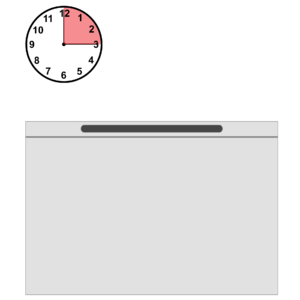Difference between revisions of "Duty cycle"
(Created page with "Category:System design thumb|right|A refrigerator operating 15 minutes out of an hour. 15 minutes ÷ 60 minutes = 25% duty cycle. There are some loa...") |
|||
| Line 1: | Line 1: | ||
[[Category:System design]] | [[Category:System design]] | ||
[[File:Dutycycle.png|thumb|right|A refrigerator operating 15 minutes out of an hour. 15 minutes ÷ 60 minutes = 25% duty cycle.]] | [[File:Dutycycle.png|thumb|right|A refrigerator operating 15 minutes out of an hour. 15 minutes ÷ 60 minutes = 25% duty cycle.]] | ||
| − | There are some loads that have a high power rating that are continuously connected to a power source, but that only actively consume their rated power during a certain percentage of each hour, like refrigerators. The percentage of time that an appliance operates during an hour or a day is referred to as its duty cycle. Most appliances that have a duty cycle only operate when a certain environmental condition is met like a high temperature inside of a refrigerator or a low quantity of water inside of a tank | + | There are some loads that have a high power rating that are continuously connected to a power source, but that only actively consume their rated power during a certain percentage of each hour, like refrigerators. The percentage of time that an appliance operates during an hour or a day is referred to as its duty cycle. Most appliances that have a duty cycle only operate when a certain environmental condition is met like a high temperature inside of a refrigerator or a low quantity of water inside of a tank. For a refrigerator it depends upon the ambient temperature, how frequently the door is opened and what is being stored in inside. The duty cycle of a large appliance like a refrigerator will greatly affect system design. It may be necessary to contact the manufacturer or perform tests in order to get an accurate estimate of the duty cycle. Old refrigerators have a higher power rating, but may have a duty cycle of around 40-50%. Newer, more efficient refrigerators often have a lower power rating, but a duty cycle that approaches 80-90%. (~40-50% of the time). In any case it is important to use a conservative (high) estimate of duty cycle when designing an off-grid PV system. |
'''Example 1:''' A refrigerator has a compressor that is rated at 160W. The appliance has been tested in a similar location and had a duty cycle of 30%. How much energy will the refrigerator consume on average during a 24 hour period? | '''Example 1:''' A refrigerator has a compressor that is rated at 160W. The appliance has been tested in a similar location and had a duty cycle of 30%. How much energy will the refrigerator consume on average during a 24 hour period? | ||
*Energy consumption = Power rating × hours × duty cycle | *Energy consumption = Power rating × hours × duty cycle | ||
*Energy consumption = 160W × 24 hours × .3 (30% duty cycle) = 1152Wh | *Energy consumption = 160W × 24 hours × .3 (30% duty cycle) = 1152Wh | ||
| + | |||
| + | ==Notes/references== | ||
Revision as of 09:56, 12 November 2020
There are some loads that have a high power rating that are continuously connected to a power source, but that only actively consume their rated power during a certain percentage of each hour, like refrigerators. The percentage of time that an appliance operates during an hour or a day is referred to as its duty cycle. Most appliances that have a duty cycle only operate when a certain environmental condition is met like a high temperature inside of a refrigerator or a low quantity of water inside of a tank. For a refrigerator it depends upon the ambient temperature, how frequently the door is opened and what is being stored in inside. The duty cycle of a large appliance like a refrigerator will greatly affect system design. It may be necessary to contact the manufacturer or perform tests in order to get an accurate estimate of the duty cycle. Old refrigerators have a higher power rating, but may have a duty cycle of around 40-50%. Newer, more efficient refrigerators often have a lower power rating, but a duty cycle that approaches 80-90%. (~40-50% of the time). In any case it is important to use a conservative (high) estimate of duty cycle when designing an off-grid PV system.
Example 1: A refrigerator has a compressor that is rated at 160W. The appliance has been tested in a similar location and had a duty cycle of 30%. How much energy will the refrigerator consume on average during a 24 hour period?
- Energy consumption = Power rating × hours × duty cycle
- Energy consumption = 160W × 24 hours × .3 (30% duty cycle) = 1152Wh
